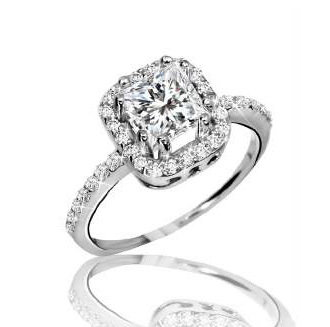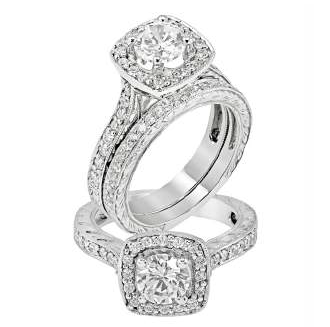There is one thing that never changes in the jewellery industry: the quest for the perfect engagement ring. Today, the unique weight of expectation and a plethora of styles and designs load the traditional symbol of love.
Engagement is, and always has been, a major part of a jeweller’s business. The engagement ring is often the most expensive piece of jewellery that a woman will acquire in her lifetime and men are forking out record amounts before getting down on bended knee.
But is getting hitched as fashionable as it once was?
An analysis of the latest Australian Bureau of Statistics (ABS) marriage data released late last year shows that the number of marriages in 2017 (112,954) has not significantly changed since 1997 (106,735).
In fact, the number of marriages decreased in 2017 by 5,447 (4.6%) and the crude marriage rate decreased from 4.9 in 2016 to 4.6 marriages per 1,000 people in 2017.
The crude marriage rate refers to the number of marriages occurring among the population of a certain geographical area during a calendar year per 1,000 of the estimated resident population. This is surprising given Australia’s population continues to increase. The peak year for marriages was 2014 with 121,197 weddings.
However, what these ABS marriage figures do not take into account is registered relationships. All state and territory Registries of Births, Deaths and Marriages, except WA and NT, provide couples an alternative to marriage where a relationship register is offered and maintained.
A registered relationship is not only a legal proof of a relationship but it can also make it easier to prove the existence of a relationship when one’s required for tax, superannuation and government payments, as well as demonstrating nextof- kin status to funeral directors and in the case of medical emergencies.
These registered relationships are not included in marriage statistics, however; while the number of registered marriages has slowly declined over time, the number of registered relationships is increasing on an annual basis. There were 14,626 relationships registered in 2017, which is more than double the number registered only five years ago in 2013 (7,281).
Divorce
More than 49,000 divorces were granted in 2017, an increase of 2,428 (5.0%) from the 46,604 in 2016. The crude divorce rate was 2.0 divorces granted per 1,000 estimated resident population, increasing slightly from 2016 (1.9).
The median age at divorce for both males and females was unchanged in 2017. For males the median age at divorce was 45.5 years of age and the median age of females was 42.9 years of age. The median duration from marriage to divorce in 2017 also remained stable at 12.0 years.
It’s often said that in Australia one in two marriages end in divorce. However, that’s likely to be a US figure and, more interestingly, it’s not as easy to accurately estimate the divorce rate.
For example, while there were 112,954 marriages in 2017 the number of divorces for the same period (49,032) does not relate to the same year, so the data is imprecise because it’s not as simple as 112,954 divided by 49,032, which would make it 43 per cent.
While the Census figures don’t indicate if the married people had previously been divorced, in 2017 more than eight out of 10 brides, and almost as many grooms, were marrying for the first time.
The pool of married people is increasing every year, since the divorce rate, which is continuing to fall, is much lower than the marriage rate. The Australian Bureau of Statistics’ annual marriage and divorce figures also showed people were choosing to get married later in life, with the national average age for a woman to wed reaching above 30 years old for the first time.
Same sex-marriage
Following the historic marriage equality vote on 9 November 2017, the ABS announced that, of the eligible Australians who voted, 61.6 per cent responded ‘Yes’ and 38.4 per cent responded ‘No’. Nearly 80 per cent of eligible Australian voters participated, with all states and territories recording a majority ‘Yes’ response.
On 9 December 2017, same-sex marriage was officially legalised and the right to marry under Australian law was no longer determined by sex or gender.
There were 3,149 same-sex marriages in the first 6 months since the changes to the Marriage Act 1961. It includes counts of samesex marriages at the national and state and territory level, as well as demographic characteristics of those who married.
Engagement
According to a survey of 3,300 couples by website Easy Weddings, 9 per cent of all engagements happen between Christmas Eve and New Year’s Day. The average cost of an engagement ring is $5,134.
About one in two engagement rings are chosen without consulting the other partner, while one in four couples decide on an engagement ring together. Six per cent of engagements are formed without a ring.
The 2018 study also found that the average age of the bride is 28 and 93 per cent are aged 35 years or under when they marry. The average age of the groom is 29 and 87 per cent of grooms are aged 35 years or under when they marry.
Is there an ‘engagement season’? The term was coined in the US to mark the period when there is an increase in engagement proposals, which spans from Thanksgiving in late November to around February. Yes, there are people who get engaged on Valentine’s Day. How original.
While Thanksgiving is not widely recognised or celebrated in Australia, the Christmas and New Year holiday period (December to January) is the time many engagements are announced, probably because couples in a more positive and relaxed, making it an ideal time to pop the question.
Coincidentally, the same holiday period is when most divorces are announced! That could also explain the spike in new members to dating websites after Christmas and into the New Year.
When it comes to choosing the wedding day, 34 per cent of couples said there was no single reason, but that it was convenient for a range of reasons. On the other hand, 21 per cent of couples said they chose their date by season, 16 per cent chose the date according to its significance to them (i.e. an anniversary), while 11 per cent of couples said they chose their wedding date according to the availability of their preferred venue.
 |  |
Above: Diamond engagement and wedding rings |
Different traditions
Even though many societal traditions have changed over the years, it’s still typical for a man to get down on bended knee when proposing to the woman in Australia. Of course, this is the point at which he presents the engagement ring.
With Australia’s increasing diversity, it’s worth noting some of the different engagement and wedding traditions of other nationalities and cultures around the world.

Scotland
| Men looking to marry are traditionally put through their paces during a “Speerin” or “Beukin,” which requires them to accomplish a series of tasks or hurdles set by the father of the bride. Also, right foot forward is the correct procedure a bride should follow when exiting her house on her way to the wedding. The ‘wedding scramble’ is traditional in most parts of Scotland. As the bride steps into the car, her father throws a handful of coins for the children to collect. It’s believed to bring about financial good fortune. |

Ireland
| The Claddagh-style ring is a traditional Irish ring full of history. The ring is made of a heart held by two hands, topped with a crown. It’s a heartfelt symbol for marriage because, traditionally, the hands represent friendship, the heart represents love and the crown represents loyalty. The Irish often wear these rings for other occasions, so to symbolise engagement, you must wear it on your left hand with the tip of the heart pointing toward your fingertips. On the day of your wedding, the heart is turned and points toward your wrist. |

China
| A wedding symbolises the joining of two families in Chinese culture, not simply the joining of a couple. Today, many Chinese proposals follow the Western tradition of presenting the woman with a diamond ring. There are still many traditional elements incorporated into Chinese proposals, however, such as the woman taking the man to meet her family, and the man seeking the favour of the woman’s family before proposing. After a man proposes to a woman, it is common that the two families officially acknowledge the event and give their blessing. |

Greece
| The man must ask the father of the bride for permission to marry. The couple must then attend three counselling sessions with a priest where they receive marriage advice. Once all the blessings are done, there’s typically a huge engagement party involving lots of friends and family. |

France
| Similar to other Western cultures, French couples typically get engaged once a man proposes to his partner. However, there’s no diamond ring presented at the time. After the woman says “yes,” and the man has asked for his future father-in-law’s blessing, after which the couple start shopping for an engagement ring together. The bride to be is then presented with her ring at a small gathering between both families. |

Japan
| A couple isn’t really engaged until there’s a yunio (Japanese for “engagement ceremony”), which involves a meeting between the families of the bride and groom and the exchange of nine symbolic gifts wrapped in rice paper. Each gift is meant to symbolise particular sentiments and well wishes for the couple, such as longevity, wealth and healthy children. |

India
| Arranged marriages are still very common in the subcontinent. In Indian and Pakistani proposal customs, the family of bridegroom makes a formal proposal to the family of the bride. In very traditional circles, the couple is not involved in the process at all. |

Pakistan
| If the bride’s family accepts the proposal from the bridegroom’s family, a special engagement party usually takes place where the groom-to-be proposes to the bride-to-be. |

Norway
| Women are known to wear engagement rings on their right hand, not their left. Many women in England, France, India, Russia and Germany do the same thing! |

Fiji
| It’s tradition that young men, in asking a young woman’s father for her hand, must take a special present: a whale’s tooth. It is a symbol of wealth and status in society. Assuming that the man receives a positive response, his next step is to make some food to be sent to the bride-to-be’s family. This is called ‘warming’ and just prior to the wedding the bride is tattooed, which is a sign of beauty in Fiji. |

Chile
| Engagement rings are not just for the women. Both the bride and groom-to-be wear rings on their right hand and swap the rings over to the third finger on their left hand on their wedding day. |

Armenia
| Engagement parties are just as big as the weddings themselves. A priest is called upon to bless the engagement ring and ask the couple to vow their love and devotion for one another. Like the Greeks, Armenians also attend counseling sessions with a priest before getting married. |

Ghana
| Traditionally, a groom and a few of his family members would knock on the bride’s family’s door and announce his intentions for marriage. This “knocking ceremony” happens only a week before the actual wedding! |